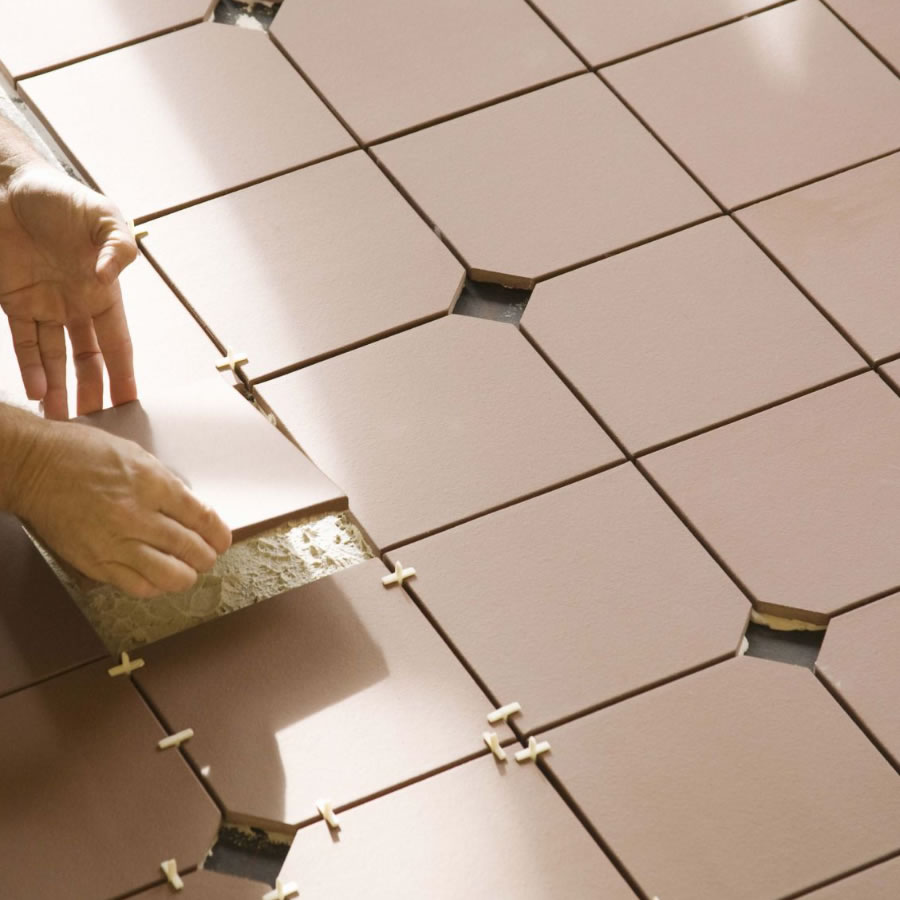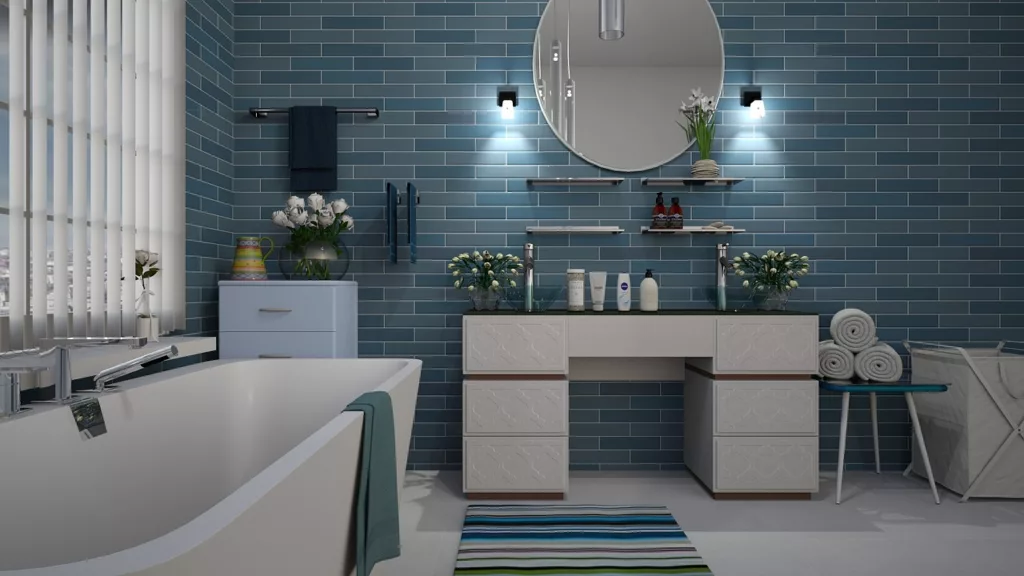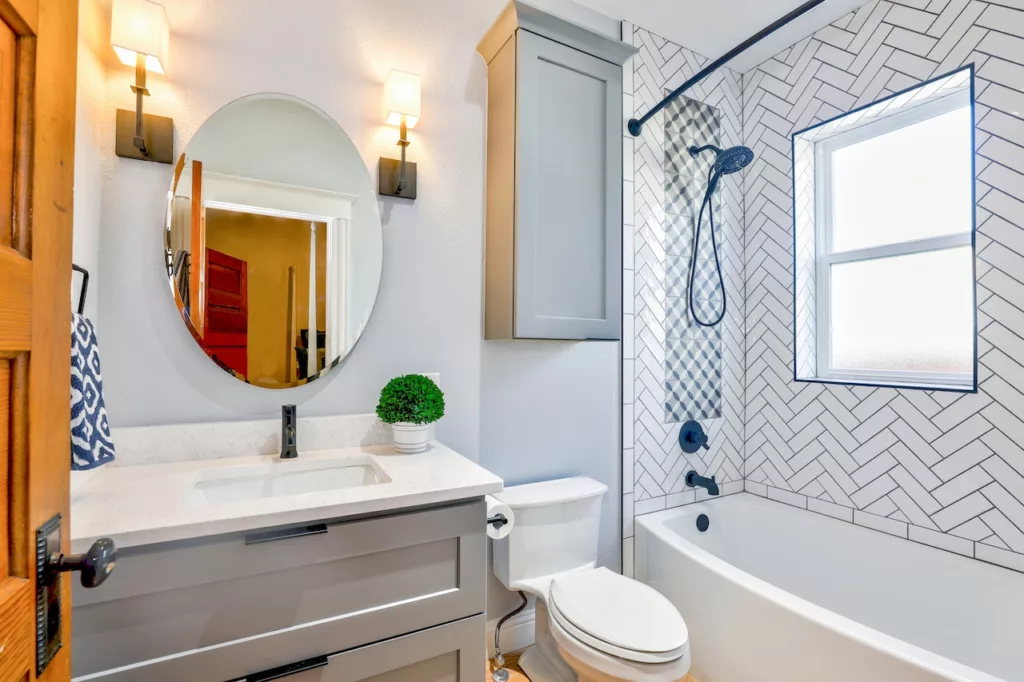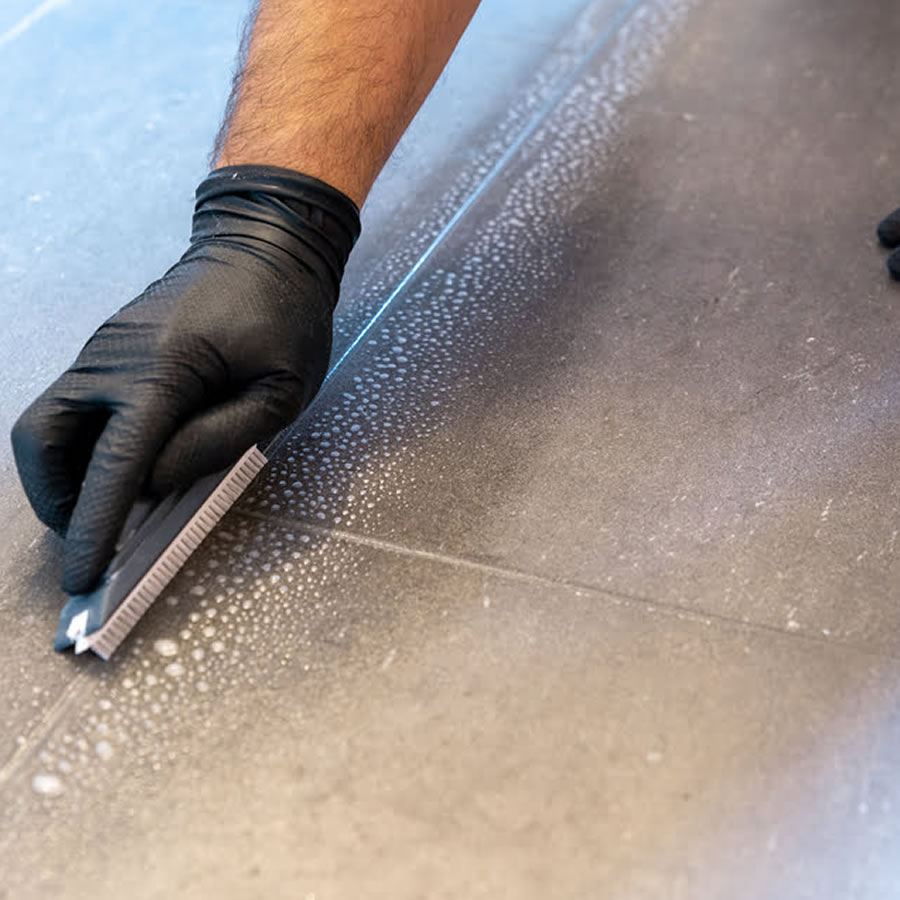When it comes to bathroom remodeling, choosing the right tile can make all the difference. With so many styles, materials, and finishes available, it’s easy to feel overwhelmed. Do you go with classic subway tiles, bold patterned designs, or sleek modern porcelain? And what about durability, maintenance, and slip resistance?
Don’t worry—we’ve got you covered! In this guide, we’ll walk you through everything you need to know before selecting tiles for your bathroom. Whether you’re updating a small powder room or designing a spa-like retreat, we’ll help you make the best choice for your home, style, and budget. Let’s dive in!
What To Consider When Choosing Tile
Picking the perfect tile for your bathroom isn’t just about looks—it’s also about functionality, durability, and long-term maintenance. With so many options available, from classic ceramic to luxurious natural stone, it’s important to weigh your choices carefully to ensure you get the best fit for your space.
Before making a decision, think about key factors like material, size, color, and texture, as well as maintenance requirements and overall budget. The right tile will not only enhance the beauty of your bathroom but also provide lasting performance for years to come. Let’s take a closer look at what you need to consider when selecting tiles for your bathroom remodel.

Consider the Tile Material and Durability
When choosing tiles for your bathroom, the material plays a huge role in both aesthetics and functionality. Porcelain and ceramic tiles are the most popular choices because they’re water-resistant, durable, and easy to maintain. If you want a more luxurious look, natural stone tiles like marble or travertine can add elegance, but they require regular sealing to prevent water damage. Glass tiles are another option, great for accent walls or shower niches, but they can be more fragile and slippery when wet. Think about where the tiles will be placed—floors, walls, or shower areas—and choose materials that will stand up to moisture and daily use.
Factor in Size, Color, and Texture
The size, color, and texture of your tiles will impact the overall feel of your bathroom. Large-format tiles can make a small bathroom look bigger by reducing grout lines, while smaller tiles, like mosaics, work well for creating visual interest or adding slip resistance to shower floors. Light-colored tiles can make a space feel more open and airy, while darker tones add warmth and sophistication. Don’t forget about texture—matte tiles offer a soft, modern look and better slip resistance, while glossy tiles reflect light beautifully but can be more slippery. Consider your style preferences and practical needs to find the perfect balance between beauty and function.
Think About Maintenance and Cleaning
Different tiles require different levels of upkeep, so it’s important to consider how much time you’re willing to spend on maintenance. Porcelain and ceramic tiles are among the easiest to clean—just a quick wipe with a damp cloth or mop keeps them looking fresh. Natural stone tiles, on the other hand, are more porous and need regular sealing to prevent stains and water damage. Grout is another factor to keep in mind. Lighter grout can brighten up your space but may show dirt more easily, while darker grout hides stains but can make a bathroom feel smaller. Choosing stain-resistant or epoxy grout can help reduce maintenance and keep your bathroom looking pristine for years to come.
Budget and Installation Costs
Your tile choice should also align with your budget, as costs can vary widely depending on material, size, and design. Ceramic tiles are usually the most budget-friendly, while porcelain costs a bit more due to its durability. Natural stone tiles tend to be the most expensive, not only in material cost but also in installation, as they often require special sealing and precise cutting. Additionally, intricate patterns or mosaic designs may require more labor, increasing the overall cost of your remodel. Be sure to factor in both material and installation expenses when making your decision, and consider whether professional installation is needed for a polished, long-lasting result.
The Best Places For Bathroom Tile
Tile isn’t just for floors—it’s one of the most versatile materials you can use in a bathroom. Whether you’re aiming for a sleek, modern look or a timeless, classic design, tile can enhance both style and function in multiple areas of your space. From durable flooring to decorative backsplashes, the right tile choices can elevate your bathroom’s aesthetic while protecting it from moisture and daily wear.
When planning your remodel, it’s important to consider where tile will be most beneficial. Flooring, walls, countertops, showers, tub surrounds, and backsplashes all offer great opportunities to incorporate beautiful and practical tile designs. Each area has different needs, so choosing the right tile type and finish will ensure your bathroom stays stylish, safe, and easy to maintain. Let’s explore the best places to use tile in your bathroom and how to make the most of each space.

Tile Flooring
Tile flooring is one of the most popular choices for bathrooms—and for good reason. Bathrooms are high-moisture areas, and tile’s water-resistant properties make it an ideal flooring option. Unlike wood or carpet, tile won’t warp, rot, or grow mold when exposed to humidity and splashes. It’s also durable and easy to clean, standing up to daily wear and tear while maintaining its beauty for years. With a variety of materials, including ceramic, porcelain, and natural stone, homeowners can choose from endless styles to match their design preferences. Additionally, modern slip-resistant tile options provide added safety, reducing the risk of slips and falls in wet areas.
Tile Walls
Tiling bathroom walls is a fantastic way to enhance both the aesthetics and functionality of your space. Bathrooms are naturally high-moisture environments, and tile acts as a protective barrier against water damage, preventing mold, mildew, and wall deterioration. Unlike painted drywall, which can absorb moisture and eventually peel or crack, tile is non-porous and easy to clean, making it a low-maintenance option for homeowners. Plus, it adds an extra layer of durability, ensuring your bathroom walls remain in great condition for years.
Beyond practicality, tile walls offer endless design possibilities. Whether you prefer a sleek, modern look with large-format tiles, a classic subway tile arrangement, or an intricate mosaic accent wall, there’s a tile style to match every aesthetic. Glossy tiles can help reflect light, making a small bathroom feel more open and airy, while matte finishes create a soft, sophisticated look. Additionally, using tile on the lower half of the walls or in high-splash areas, like behind the sink or toilet, can add both protection and visual appeal. With so many colors, patterns, and textures available, tiled walls are a great way to bring personality and long-lasting beauty to your bathroom.
Tile Countertops
Tile countertops in bathrooms are a practical and stylish choice that combines durability, affordability, and design versatility. Unlike solid stone or laminate surfaces, tile countertops offer a customizable look with endless options in color, pattern, and texture. Ceramic and porcelain tiles are particularly popular because they are moisture-resistant, easy to clean, and highly durable. Since bathrooms are high-humidity areas, having a non-porous countertop surface helps prevent water damage, staining, and mildew buildup. Additionally, tile countertops can withstand heat from styling tools like curling irons and straighteners, making them a great option for busy bathrooms.
One of the biggest advantages of tile countertops is their cost-effectiveness. While materials like granite, quartz, or marble can be expensive, tile allows homeowners to achieve a similar upscale look at a fraction of the price. With options that mimic natural stone or feature unique mosaic patterns, tile countertops can add a high-end touch to any bathroom design. The main drawback is grout lines, which require regular cleaning and sealing to prevent stains and mildew. However, with proper maintenance and stain-resistant grout options, tile countertops can remain a beautiful and functional addition to your bathroom for years to come.
Tile Showers
Tile is one of the best choices for shower walls and floors because it combines durability, water resistance, and aesthetic appeal. Showers are exposed to constant moisture, and tile creates a protective, waterproof barrier that prevents damage to the underlying walls and floors. Unlike fiberglass or acrylic shower surrounds, which can look plain and wear out over time, tile allows for a fully customized design that enhances the overall look of your bathroom. Porcelain and ceramic tiles are the most common choices for showers due to their low porosity, easy maintenance, and wide variety of styles. Natural stone tiles, such as marble or travertine, add a luxurious feel but require sealing to prevent water absorption.
Tile Tub Surrounds
A tiled tub surround is a fantastic way to enhance both the functionality and aesthetic appeal of your bathroom. Since bathtubs are exposed to constant moisture, steam, and splashes, a properly installed tile surround acts as a protective barrier, preventing water from seeping into the walls and causing damage like mold or mildew. Unlike painted drywall, which can peel or absorb moisture over time, tile provides a durable, water-resistant surface that stands up to daily use. Porcelain and ceramic tiles are the most popular choices due to their affordability, low maintenance, and wide variety of design options. For a more high-end, spa-like feel, natural stone tiles such as marble or travertine can be used, though they require regular sealing to prevent water absorption.
Tile Backsplash
A tile backsplash is a simple yet impactful addition to any bathroom, offering both practical benefits and aesthetic appeal. Positioned behind sinks and vanities, a backsplash serves as a protective barrier against water splashes, soap scum, and everyday messes that can damage painted walls or wallpaper. Unlike drywall, which can absorb moisture and develop mold or mildew over time, tile is water-resistant and easy to wipe clean, making it a low-maintenance solution for busy bathrooms. Porcelain and ceramic tiles are popular choices due to their durability and affordability, while glass, marble, and mosaic tiles add a more decorative and high-end touch.
Choosing Tile Materials for Your Bathroom
When selecting tile for your bathroom, the material you choose will impact both the look and functionality of the space. Ceramic and porcelain tiles are the most popular choices due to their durability, affordability, and water resistance. Porcelain is denser and more resistant to moisture than ceramic, making it ideal for high-traffic areas like floors and showers. Both come in a variety of colors, patterns, and finishes, allowing you to achieve anything from a sleek modern look to a traditional aesthetic.
If you’re looking for something unique, glass tiles add a beautiful, reflective quality that works well for backsplashes and accent walls, though they can be more slippery and require careful installation. For a more natural and luxurious feel, stone tiles such as marble, travertine, slate, and granite bring warmth and elegance to a bathroom. However, they require sealing to prevent water absorption and staining.

Ceramic Tiles: A Classic Choice for Bathroom Tiles
Ceramic tiles are one of the most popular and practical choices for bathroom flooring, walls, and backsplashes. Made from natural clay that is fired at high temperatures, ceramic tiles are durable, water-resistant, and easy to maintain—making them ideal for high-moisture areas like bathrooms. They come in a vast range of colors, shapes, and finishes, from glossy to matte, allowing homeowners to customize their space with a look that suits their style. Ceramic tiles are also budget-friendly compared to other materials, offering a cost-effective way to achieve a polished and timeless aesthetic. While they are not as dense as porcelain tiles, they still provide excellent durability for bathroom surfaces. One of the key advantages of ceramic tile is its ease of cleaning—regular sweeping and occasional mopping keep it looking fresh. With proper installation and maintenance, ceramic tile can last for decades, making it a reliable and stylish choice for any bathroom.
History of Ceramic Tiles
Ceramic tiles have been used for thousands of years, dating back to ancient civilizations. The earliest known examples of ceramic tiles were found in Mesopotamian ruins from around 4,000 BCE, where they were used to decorate walls. The Egyptians later refined the art of ceramic tile-making, using brightly colored glazed. By the time of the Roman Empire, ceramic tiles had become widely used for mosaics in public baths and villas. Thanks to advancements in manufacturing, ceramic tiles are now more durable and accessible than ever, continuing their legacy as a staple in home design.
Porcelain Tiles: A Durable Choice for Bathrooms
Porcelain tiles are one of the best choices for bathrooms due to their exceptional durability, water resistance, and elegant appearance. Made from refined clay and fired at higher temperatures than ceramic, porcelain tiles are denser, less porous, and more resistant to moisture—making them ideal for wet environments like showers, floors, and walls. Their strength also makes them highly resistant to scratches, stains, and heavy foot traffic, ensuring long-lasting beauty and performance. Available in a wide range of designs, including stone and wood-look finishes, porcelain tiles can mimic high-end materials without the maintenance concerns. Their low absorption rate makes them easy to clean, requiring only basic sweeping and mopping. Additionally, many porcelain tiles come with slip-resistant textures, adding safety to wet areas. While porcelain is slightly more expensive than ceramic, its durability and minimal upkeep make it a worthwhile investment for any bathroom.
History of Porcelain
Porcelain has a rich history dating back to ancient China, where it was first developed about 1,500 years ago. They used a refined form of clay and fired it at extremely high temperatures to create a hard, translucent, and highly durable material. Porcelain became highly prized in trade and intricate blue-and-white porcelain became a symbol of wealth and craftsmanship. By the 18th century, European manufacturers discovered how to produce porcelain, leading to its widespread use in art, dinnerware, and architecture. Today, advancements in technology have made porcelain tiles more accessible and versatile, allowing homeowners to enjoy their beauty and durability in modern bathrooms.
Glass Tiles: A Sleek Choice for Bathrooms
Glass tiles are a stunning option for bathrooms, offering a sleek, modern look with a luminous, reflective quality that can brighten up any space. These bathroom tiles are made from thin layers of glass that are heat-treated for durability, making them resistant to moisture, stains, and mold—perfect for humid bathroom environments. Glass tiles are often used for backsplashes, shower walls, and accent features, adding a touch of elegance and visual interest. They come in a variety of colors, finishes, and sizes, from translucent and frosted to glossy and iridescent, allowing for endless design possibilities. One of the biggest advantages of glass tiles is their ability to reflect light, making small bathrooms appear more open and airy. They are also easy to clean, as their smooth surface prevents grime buildup. However, glass tiles can be more expensive than ceramic or porcelain, and their glossy finish can be slippery, making them better suited for walls and decorative accents rather than flooring. Despite these considerations, glass tiles remain a top choice for homeowners looking to add a luxurious, high-end touch to their bathrooms.
History of Glass Tiles
Glass tiles have a rich history dating back over 4,000 years to ancient Mesopotamia and Egypt, where artisans created small, colorful glass mosaics to adorn temples and palaces. The Romans further advanced glass tile production, using them extensively in their luxurious bathhouses and grand villas. During the Byzantine period (4th–15th century CE), glass mosaic tiles became a signature of religious architecture, with intricate gold and colored glass designs embellishing churches and cathedrals. In the modern era, innovations in glass manufacturing have made glass tiles more durable and accessible, leading to their widespread use in interior design. Today, they continue to be a symbol of sophistication, bringing both historical craftsmanship and contemporary elegance into bathroom spaces.
Stone Tiles: A Natural Choice for Bathrooms
Stone tiles bring a timeless, organic beauty to bathrooms, offering a rich, textured look that adds warmth and elegance to any space. Made from natural materials like marble, travertine, slate, and granite, stone tiles provide unique variations in color and pattern, ensuring no two tiles are exactly alike. One of the biggest advantages of stone tiles is their durability—they can last a lifetime with proper care. They also add value to a home, as natural stone is often associated with high-end design. However, because stone is porous, it requires regular sealing to prevent water absorption, stains, and mold growth, making maintenance a key consideration. Some stone types, like slate and textured granite, offer excellent slip resistance, making them a great choice for bathroom flooring, while polished marble and limestone work beautifully on walls and countertops. While stone tiles tend to be more expensive than ceramic or porcelain, their luxurious appearance and longevity make them a worthwhile investment for those looking to create a spa-like retreat in their bathroom.
History of Stone Tiles
Stone tiles have been used in architecture and interior design for thousands of years, dating back to ancient civilizations such as Egypt, Greece, and Rome. The Egyptians used limestone and granite to construct grand temples and tombs, while the Greeks perfected the art of marble carving, using it in their iconic columns and bathhouses. The Romans, known for their advanced engineering, incorporated stone tiles into their elaborate bathhouses, villas, and mosaics, many of which still stand today. During the Renaissance, stone became a staple in European palaces and cathedrals, symbolizing wealth and sophistication. With modern quarrying and cutting techniques, natural stone tiles have become more accessible, allowing homeowners to bring this timeless material into contemporary bathrooms while maintaining its historic charm and durability.
Talk To A Tile Installation Specialist
If you are considering having tile installed in your bathroom, it is important to talk to a specialist to get an estimate and discuss your options. A qualified installer will be able to help you choose the right type of tile for your bathroom, and they will ensure that the tile is installed correctly and professionally.

Project Scope and Tile Selection
Before starting your bathroom tile project, it’s important to discuss the full scope of work with your tile installation company. Be clear about which areas you want tiled—whether it’s the flooring, shower, tub surround, walls, or backsplash—and what look you’re trying to achieve. Your installer can help you choose the right type of tile based on durability, moisture resistance, and maintenance requirements. For example, if you want a low-maintenance option, porcelain may be a better choice than natural stone. If you have a specific design in mind, ask about tile size, color, and layout patterns to ensure it complements your bathroom’s overall style.
Installation Process and Timeline
Understanding the installation process and expected timeline will help set realistic expectations for your project. Ask your installer how long the job will take and whether any prep work is needed before installation, such as removing old tile, repairing subflooring, or waterproofing. If you’re tiling a shower or tub surround, discuss the steps they’ll take to prevent water damage and leaks, such as using the right waterproof membranes or backer boards. Also, confirm how long you’ll need to wait before using your bathroom after installation—some tiles and grout require a curing period before they’re fully set.
Budget, Labor Costs, and Warranty
Finally, it’s essential to discuss pricing and warranties upfront to avoid surprises. Ask for a detailed estimate that includes materials, labor, and any additional costs for prep work, sealing, or special tile cutting. Some tile designs, like intricate mosaics or diagonal layouts, may require more labor and increase the overall cost. Also, check whether the company offers a warranty on both the materials and workmanship, so you’re covered if any issues arise after installation. A reputable tile installer will be transparent about costs and provide a clear contract outlining what’s included, ensuring you get high-quality results without unexpected expenses.
Hire A Tile Expert in Nashville
If you’re ready to upgrade your bathroom with beautiful, high-quality tile, MidTenn Handyman is here to help! As Nashville’s local and friendly handyman service, we specialize in expert tile installation and bathroom remodeling, ensuring your project is done right the first time. Whether you’re looking to install durable porcelain flooring, a stylish subway tile shower, or a custom stone tile vanity backsplash, our skilled team has the experience and tools to bring your vision to life.
Plus, hiring a handyman instead of a big remodeling company can save you money without sacrificing quality. We take pride in delivering professional craftsmanship at affordable prices, helping you transform your bathroom into a functional and stylish space. Call MidTenn Handyman today to discuss your project, get a free estimate, and let us handle all the details so you can enjoy a stunning new bathroom with none of the stress!
